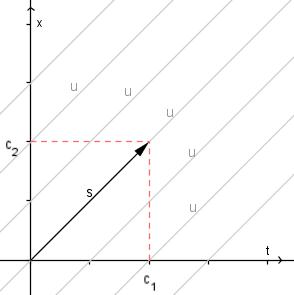Last time we derived a simple PDE describing the process of non-diffusive advection in a constantly flowing stream of water. That PDE looked like this: , where
was the constant speed of the water. The solution of this PDE is a function of the form
.
This PDE follows a more general form that looks like this: , where
and
are constants. If you’ve studied multivariable calculus, you might recognize this kind of equation. It is, in fact, a directional derivative.
We can rewrite , where
. We can read this equation as “the gradient (or derivative) of
in the direction of
is zero”. Which means that in the direction
, the solution
attains the same constant value. It may be easier to see by graphing it:

Recent Comments